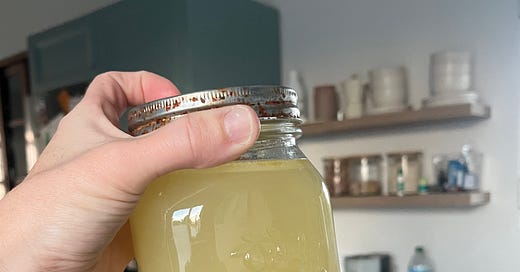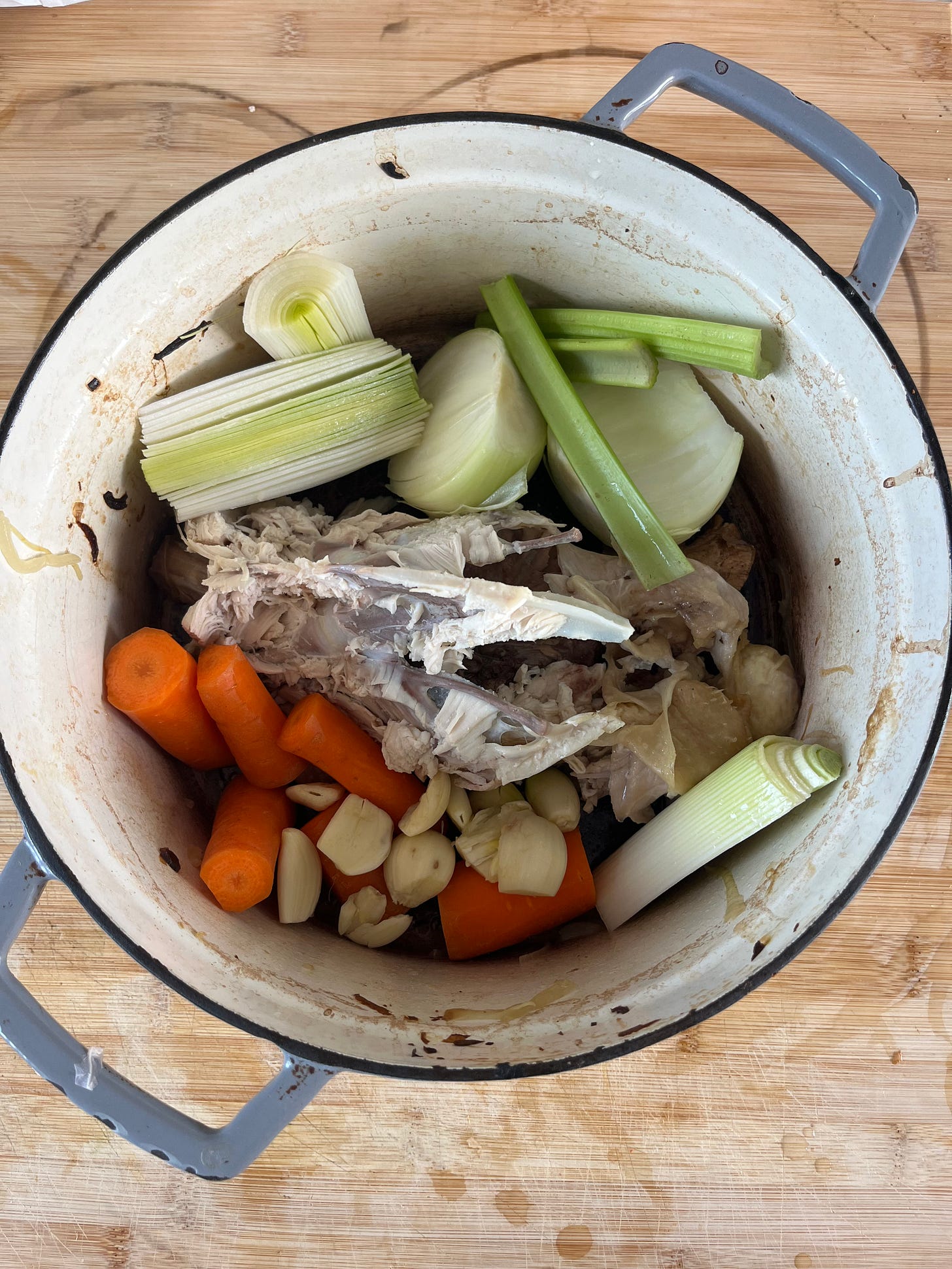Recipe: Really good chicken bone broth
The nourishing recipe I’ve perfected over the last three years
Hi all, it’s Meredith! I have gone through lots of cooking phases, each to match the stage of life I was in: easy, budget-friendly foods (featuring instant ramen noodles) in my early 20s, lean and green meal prep Sundays for long commutes and longer workdays in my mid-20s, and then the occasional slow-cooker meal in my late 20s in Brooklyn, a time where I almost always ate out. But my favorite phase of cooking so far is the one I’m in now: flavorful dishes that fulfill my occasional craving for something I can’t get delivered, and, most importantly, nourishing foods that satisfy the needs and wants of my family.
I started making a whole chicken once a month (sometimes twice) a couple of years ago, after I realized how much less expensive it was to buy the whole thing vs. just chicken breast, thighs, or drumsticks. I’m actually surprised I didn’t do this in my meal prep days, but I think I was intimidated by it.
I made my first broth when I was preparing for my first postpartum journey. I listened to The First Forty Days and read through Nuturing Your New Life (gifted to me by Katie!) and was inspired by the thought of having something nourishing in the freezer that could be a meal on its own or the base of something else. I can’t tell you how many times I heated up a frozen cube of broth in my mug before sitting down to nurse my son. I struggled so much with breastfeeding in the beginning (more on that here), and it was really great to focus on that and not on what to feed myself. I made another big batch just before Lola was born, and it was a godsend when I was shaking like a leaf from a mastitis-induced fever.
Now, you’ll rarely find my freezer without a bag full of frozen cubes of broth. These days there are two bags: one with large cubes of salted broth for us, and another with little cubes of unsalted broth for Lola. (By the way—a lot of influencers rave about souper cubes… anyone here have them? Are they worth the pricetag?)
The first step is to roast your chicken, whether you do it whole, spatchcocked, or cut into pieces. Once the chicken has been carved, I toss the bones and/or carcass in my dutch oven with whatever vegetables I have in the fridge, cover it with water, and let it simmer all day long. The broth is nutrient-dense and really tasty. We’ve included a few ideas for what you can do with it below the recipe. Let us know if you try it! -Meredith
Really good chicken bone broth
Yields: 10 cups broth
Cook time: 4 hours
Ingredients:
1 whole chicken carcass
1 onion
1 head of garlic
1 leek
2 carrots
2 celery stalks
1-inch piece ginger
8-10 cups of water
1 heaping tablespoon of coarse sea salt
Instructions:
Put your chicken carcass in the stock pot or dutch oven, cover with water, and turn it on medium as you prepare the rest of your ingredients.
Prepare your vegetables: Remove the skin from the onion and cut in half, peel the garlic, slice the leek in half and rinse the layers inside, peel carrots, wash the celery stalks. Cut leeks, carrots, and celery into 4-inch pieces, and place in the pot with the chicken carcass and water. Add the ginger (no need to peel it!).
Add salt and make sure your ingredients are covered with water (about 8-10 cups). Bring to a boil and skim the impurities off the top. Cover and simmer on low for 4 hours. Taste the broth—does it need more salt? It probably does!
A note on vegetables: You can use whatever vegetables you have in the fridge! I love to add a chunk of butternut squash (if I have it) to give the broth a bit of a smoother taste and texture.
A note on salt: The amount of salt you use will vary depending on the type of salt you have and how much your tastebuds need. I use coarse sea salt and generally add a small handful of it to the broth. It doesn’t make the broth salty, but it elevates the taste and brings out the flavors of the vegetables.
Five ways to use your chicken broth
On its own: Have it in a mug or a bowl—so comforting! -Meredith
Albóndigas en caldo: My mother-in-law showed me this dish, and I make it often! Bring your broth to a simmer, and drop in the raw meatballs (1/2 kilo of meat, 2 eggs, 1/4 cup bread crumbs, one crushed clove of gralic, salt and pepper!) one by one, right into the broth, until they cook and float to the top of the broth, about 10-15 minutes. -Katie
Elevate a basic puree: Add it to any other puree or soup you’ve got on your list (like my favorite roasted butternut squash soup). -Meredith
An easy flavor & nutrient boost: Use it to cook your pasta or rice (an excellent hack if you’ve got a selective young eater in your house!) You can even blend in the veggies from the broth to give it a thicker consistency. -Meredith
Kid-friendly soup (that we adults love, too): My kids go wild for broth cooked with small pasta, carrots, and whatever leftover meat there is from cooking the broth. It’s perfect for busy weekdays, too. I put the broth to boil, add whatever’s leftover from making the broth in terms of veg or meat, and then tiny star pasta. My husband and I love it almost as much as they do! -Katie
When in doubt, freeze!: As Meredith said, there’s nothing as valuable as frozen broth in the freezer. I love the idea of freezing it in small cubes—it’s the perfect amount to pull out and deglaze a pan and make a delicious pan sauce. -Katie







I love the souper cubes. The size works better than ice cube trays... more practical. Also, because they have lids, they're more user friendly.